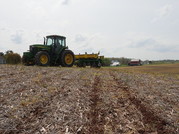
“I'm so glad I live in a world where there are Octobers.”
― L. M. Montgomery
As I drive through our beautiful state this month I think of this quote and how appropriate it is, especially when you live and farm in New York. On my farm we are finishing up the harvest from our fields, seeding the winter cover crops, and planting the high tunnels for winter greens. I hope you are having a safe and successful harvest season as well.
In our FSA offices we are approaching the October 31 deadline for two programs: Organic and Transitional Education Certification Program (OTECP) and Organic Certification Cost Share Program (OCCSP). These programs help producers cover the cost of organic certification, transition, and other related expenses.
In addition, the acreage reporting deadline for fall planted small grains is November 15, and the Noninsured Crop Disaster Assistance Program (NAP) deadline for perennial fruits and nuts, strawberries, asparagus, ginger and rhubarb is November 21. If damaging weather has affected your crops recently, this is a program you'll want to look into to help safeguard your income when damage occurs.
As winter approaches, and farmers have a little more time for gathering, please let your local FSA office, or myself, know if an organization of farmers you're part of is meeting and would like us to attend. We'd love to meet with producers to hear what is on their mind and to have an opportunity to share what FSA does to support the farms and farmers in New York State.
All the best,
Jim Barber
|

Agricultural producers and handlers who are certified organic, along with producers and handlers who are transitioning to organic production, can now apply for the U.S. Department of Agriculture’s (USDA) Organic and Transitional Education Certification Program (OTECP) and Organic Certification Cost Share Program (OCCSP), which help producers and handlers cover the cost of organic certification, along with other related expenses. Applications for OTECP and OCCSP are both due October 31, 2022.
OTECP covers:
- Certification costs for organic producers and handlers (25% up to $250 per category).
- Eligible expenses for transitional producers, including fees for pre-certification inspections and development of an organic system plan (75% up to $750).
- Registration fees for educational events (75% up to $200).
- Soil testing (75% up to $100).
Meanwhile, OCCSP covers 50% or up to $500 per category of certification costs in 2022.
This cost share for certification is available for each of these categories: crops, wild crops, livestock, processing/handling and State organic program fees.
Producers can receive cost share through both OTECP and OCCSP. Both OTECP and OCCSP cover costs incurred from October 1, 2021, to September 30, 2022. Producers have until October 31, 2022 to file applications, and FSA will make payments as applications are received.
To apply, producers and handlers should contact the Farm Service Agency (FSA) at their local USDA Service Center. As part of completing the OCCSP applications, producers and handlers will need to provide documentation of their organic certification and eligible expenses. Organic producers and handlers may also apply for OCCSP through participating State agencies.
Additional details can be found on the OTECP and OCCSP webpages.
|

Agricultural producers who have not yet completed their crop acreage reports after spring planting should make an appointment with their local Farm Service Agency (FSA) before the applicable deadline.
An acreage report documents a crop grown on a farm or ranch and its intended uses. Filing an accurate and timely acreage report for all crops and land uses, including failed acreage and prevented planted acreage, can prevent the loss of benefits.
The following acreage reporting dates are applicable for New York:
- November 15, 2022 - Fall Seeded Small Grains
- January 3, 2023 - Maple Taps & Honeybees
How to File a Report
Service Center staff continue to work with agricultural producers via phone, email, and other digital tools. Because of the pandemic, some USDA Service Centers are open to limited visitors. Contact the Name County FSA office to set up an in-person or phone appointment.
To file a crop acreage report, you will need to provide:
- Crop and crop type or variety.
- Intended use of the crop.
- Number of acres of the crop.
- Map with approximate boundaries for the crop.
- Planting date(s).
- Planting pattern, when applicable.
- Producer shares.
- Irrigation practice(s).
- Acreage prevented from planting, when applicable.
- Other information as required.
Acreage Reporting Details
The following exceptions apply to acreage reporting dates:
- If the crop has not been planted by the acreage reporting date, then the acreage must be reported no later than 15 calendar days after planting is completed.
- If a producer acquires additional acreage after the acreage reporting date, then the acreage must be reported no later than 30 calendar days after purchase or acquiring the lease. Appropriate documentation must be provided to the county office.
Producers should also report crop acreage they intended to plant, but due to natural disaster, were unable to plant. Prevented planting acreage must be reported on form CCC-576, Notice of Loss, no later than 15 calendar days after the final planting date as established by FSA and USDA’s Risk Management Agency.
Noninsured Crop Disaster Assistance Program (NAP) policy holders should note that the acreage reporting date for NAP-covered crops is the earlier of the dates listed above or 15 calendar days before grazing or harvesting of the crop begins.
|
U.S. Department of Agriculture (USDA) Secretary Tom Vilsack announced that the Biden-Harris Administration is making $500 million in grants available to increase American-made fertilizer production to spur competition and combat price hikes on U.S. farmers caused by the war in Ukraine.
The Biden-Harris Administration’s Fertilizer Production Expansion Program is part of a whole-of-government effort to promote competition in agricultural markets. The funds are being made available through the Commodity Credit Corporation.
Eligible entities are for‐profit businesses and corporations, nonprofit entities, Tribes and Tribal organizations, producer‐owned cooperatives and corporations, certified benefit corporations, and state or local governments. Private entities must be independently owned and operated to apply.
The Department will begin accepting applications in the coming days via www.grants.gov. Notably, there will be two opportunities for submission. Learn more.

The USDA Farm Service Agency (FSA) encourages you to review available USDA crop risk protection options, including federal crop insurance and Noninsured Crop Disaster Assistance Program (NAP) coverage, before the crop deadline of November 21.
Federal crop insurance covers crop losses from natural adversities such as drought, hail and excessive moisture. NAP covers losses from natural disasters on crops for which no permanent federal crop insurance program is available.
The following crops in have a NAP application deadline of November 21: perennial fruits and nuts, strawberries, asparagus, ginger, horseradish, and rhubarb
You can determine if crops are eligible for federal crop insurance or NAP by visiting the RMA website.
NAP offers higher levels of coverage, from 50 to 65 percent of expected production in 5 percent increments, at 100 percent of the average market price. Producers of organics and crops marketed directly to consumers also may exercise the “buy-up” option to obtain NAP coverage of 100 percent of the average market price at the coverage levels of between 50 and 65 percent of expected production. NAP basic coverage is available at 55 percent of the average market price for crop losses that exceed 50 percent of expected production.
For all coverage levels, the NAP service fee is the lesser of $325 per crop or $825 per producer per county, not to exceed a total of $1,950 for a producer with farming interests in multiple counties.
Beginning, underserved, veterans and limited resource farmers are now eligible for free catastrophic level coverage.
Federal crop insurance coverage is sold and delivered solely through private insurance agents. Agent lists are available at all USDA Service Centers or at USDA’s online Agent Locator. You can use the USDA Cost Estimator to predict insurance premium costs.
For more information on NAP, service fees, sales deadlines, contact your local USDA Service Center or visit fsa.usda.gov.
Qualified veteran farmers or ranchers are eligible for a service fee waiver and premium reduction, if the NAP applicant meets certain eligibility criteria.
|

Agriculture Secretary Tom Vilsack announced that the Biden-Harris Administration through the U.S. Department of Agriculture is investing up to $2.8 billion in 70 selected projects under the first pool of the Partnerships for Climate-Smart Commodities funding opportunity, with projects from the second funding pool to be announced later this year. Ultimately, USDA’s anticipated investment will triple to more than $3 billion in pilots that will create market opportunities for American commodities produced using climate-smart production practices. These initial projects will expand markets for climate-smart commodities, leverage the greenhouse gas benefits of climate-smart commodity production and provide direct, meaningful benefits to production agriculture, including for small and underserved producers. Applicants submitted more than 450 project proposals in this first funding pool, and the strength of the projects identified led USDA to increase its investment in this opportunity from the initial $1 billion Vilsack announced earlier this year. Read more here.
|

Farmers can use USDA farm ownership microloans to buy and improve property. These microloans are especially helpful to beginning or underserved farmers, U.S. veterans looking for a career in farming, and those who have small and mid-sized farming operations.
Microloans have helped farmers and ranchers with operating costs, such as feed, fertilizer, tools, fencing, equipment, and living expenses since 2013.
Microloans can also help with farmland and building purchases and soil and water conservation improvements. FSA designed the expanded program to simplify the application process, expand eligibility requirements and expedite smaller real estate loans to help farmers strengthen their operations. Microloans provide up to $50,000 to qualified producers and can be issued to the applicant directly from the USDA Farm Service Agency (FSA).
To learn more about the FSA microloan program, contact your local USDA Service Center or visit fsa.usda.gov/microloans.
|
Did you know that farmers are more likely than the general population to die by suicide?
NY FarmNet is collaborating with county Cornell Cooperative Extension offices this fall to offer free, full day, in person Mental Health First Aid (MHFA) courses. Farmers, agribusiness workers, and anyone who interacts with the agricultural community in New York is encouraged to attend. Trainings run from 8am to 5pm, and lunch will be provided from a local eatery with a one hour break.
Mental Health First Aid teaches you how to identify, understand, and respond to signs of mental health and substance use challenges among adults. You’ll build skills and confidence you need to reach out and provide initial support to those who are struggling. You’ll also learn how to help connect them to appropriate support.
After the course, you will be able to:
- Recognize common signs and symptoms of mental health and substance use challenges.
- Understand how to interact with a person in crisis and connect them with help.
- Use self-care tools and techniques.
The instructors for these courses are part of a recently trained cohort that work within the NY agricultural community. They include representatives from NY FarmNet, Cornell Cooperative Extension, Farm Bureau, Young Farmers Coalition, NY Center for Ag Medicine and Health (NYCAMH), and Black Farmers United NYS.
Scheduled full day MHFA trainings for this fall include:
Tuesday, October 18th in Hudson/Columbia County
Wednesday, October 19th in Cortland/Cortland County
Friday, October 21st in Ithaca/Cornell University/Tompkins County
Tuesday, October 25th in Middletown/Orange County
Wednesday, November 2nd in Binghamton/Broome County
Monday, November 7th in Lockport/Niagara County
Tuesday, November 8th in Fonda/Montgomery County
To register, go to www.nyfarmnet.org/trainings. If we don’t yet have a training scheduled in your area, check back soon, or contact NY FarmNet at 1-800-547-3276 or nyfarmnet@cornell.edu.
These free trainings are made possible by funding from the United States Department of Agriculture’s National Institute of Food & Agriculture. They have invested nearly $25 million in addressing farmer behavioral health on a state by state basis as part of the Farm and Stress Assistance Network (FRSAN) through state Departments of Agriculture.

Farm Service Agency (FSA) is committed to providing our farm loan borrowers the tools necessary to be successful. FSA staff will provide guidance and counsel from the loan application process through the borrower’s graduation to commercial credit. While it is FSA’s commitment to advise borrowers as they identify goals and evaluate progress, it is crucial for borrowers to communicate with their farm loan staff when changes occur. It is the borrower’s responsibility to alert FSA to any of the following:
- Any proposed or significant changes in the farming operation
- Any significant changes to family income or expenses
- The development of problem situations
- Any losses or proposed significant changes in security
If a farm loan borrower can’t make payments to suppliers, other creditors, or FSA on time, contact your farm loan staff immediately to discuss loan servicing options.
For more information on FSA farm loan programs, contact your local USDA Service Center or visit fsa.usda.gov.
|

The U.S. Department of Agriculture (USDA) is offering virtual workshops – on Oct. 13, Nov. 15, and Dec. 13 – for agricultural producers and stakeholders to learn about the latest updates and improvements to the Whole-Farm Revenue Protection (WFRP) and the Micro Farm insurance options, two of the most comprehensive risk management options available. These insurance options are especially important to specialty crop, organic, urban, and direct market producers, and this is part of the USDA’s Risk Management Agency (RMA) efforts to increase participation in these options and crop insurance overall.
RMA will host these workshops for agricultural producers via Microsoft Teams events:
RSVP is not required. Attendees will have a chance to submit written questions during the event.
Learn more.
|
|